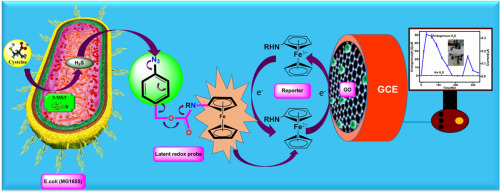Biosensors and Bioelectronics ( IF 10.7 ) Pub Date : 2017-05-04 , DOI: 10.1016/j.bios.2017.05.006 Kesavan Manibalan , Veerappan Mani , Pu-Chieh Chang , Chih-Hung Huang , Sheng-Tung Huang , Kasper Marchlewicz , Suresh Neethirajan

|
Hydrogen sulfide (H2S) was discovered as a third gasotransmitter in biological systems and recent years have seen a growing interest to understand its physiological and pathological functions. However, one major limiting factor is the lack of robust sensors to quantitatively track its production in real-time. We described a facile electrochemical assay based on latent redox probe approach for highly specific and sensitive quantification in living cells. Two chemical probes, Azido Benzyl ferrocene carbamate (ABFC) and N-alkyl Azido Benzyl ferrocene carbamate (NABFC) composed of azide trigger group were designed. H2S molecules specifically triggered the release of reporters from probes and the current response was monitored using graphene oxide film modified electrode as transducer. The detection limits are 0.32 µM (ABFC) and 0.076 µM (NABFC) which are comparable to those of current sensitive methods. The probes are successful in the determination of H2S spiked in whole human blood, fetal bovine serum, and E. coli. The continuous monitoring and quantification of endogenous H2S production in E. coli were successfully accomplished. This work lays first step stone towards real-time electrochemical quantification of endogenous H2S in living cells, thus hold great promise in the analytical aspects of H2S.
中文翻译:

电化学潜伏氧化还原比例探针,用于实时跟踪和定量活细胞中内生硫化氢的产生
硫化氢(H 2 S)被发现是生物系统中的第三种气体递质,近年来,人们越来越了解其生理和病理功能。但是,一个主要的限制因素是缺乏强大的传感器来实时定量地跟踪其生产。我们描述了一种基于潜在氧化还原探针方法的简便电化学测定法,用于活细胞中的高特异性和灵敏定量。设计了两个化学探针:叠氮化物触发基团组成的叠氮基苄基二茂铁氨基甲酸酯(ABFC)和N-烷基叠氮基苄基二茂铁氨基甲酸酯(NABFC)。高2S分子特异地触发了探针从探针中的释放,并使用氧化石墨烯膜修饰的电极作为传感器来监测电流响应。检测限为0.32 µM(ABFC)和0.076 µM(NABFC),与电流敏感方法相当。探针是成功的H的判定2 S IN人全血,胎牛血清,并掺入大肠杆菌。成功完成了对大肠杆菌中内源H 2 S产量的连续监测和定量。这项工作为活细胞中内源H 2 S的实时电化学定量奠定了基础,因此在H 2的分析方面具有广阔的前景S.











































 京公网安备 11010802027423号
京公网安备 11010802027423号